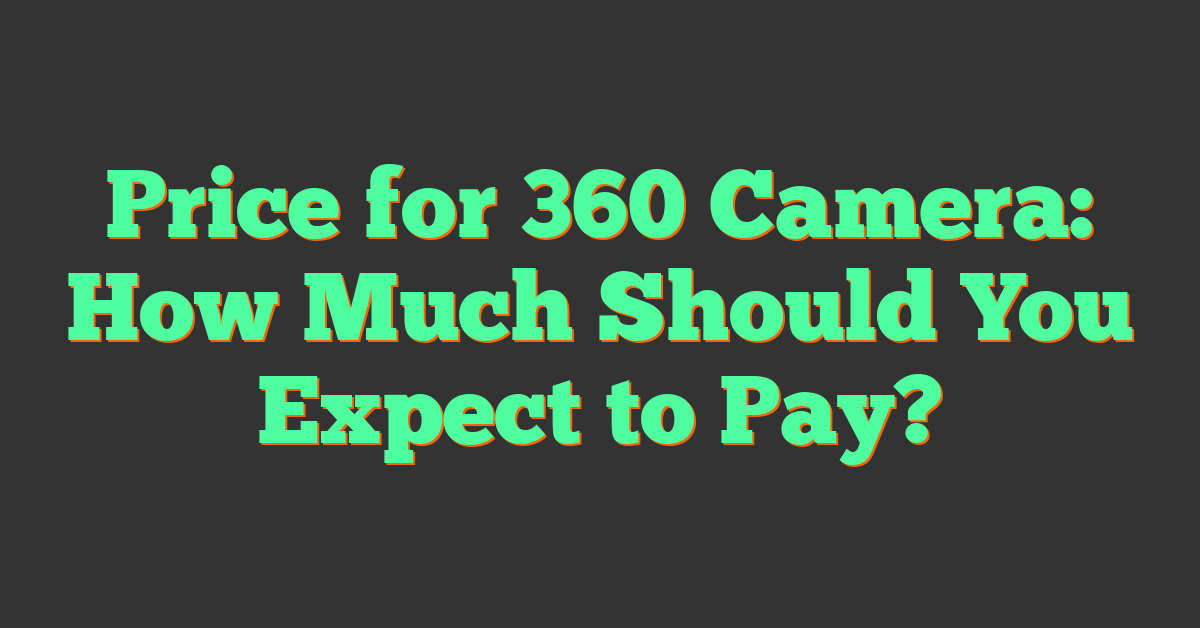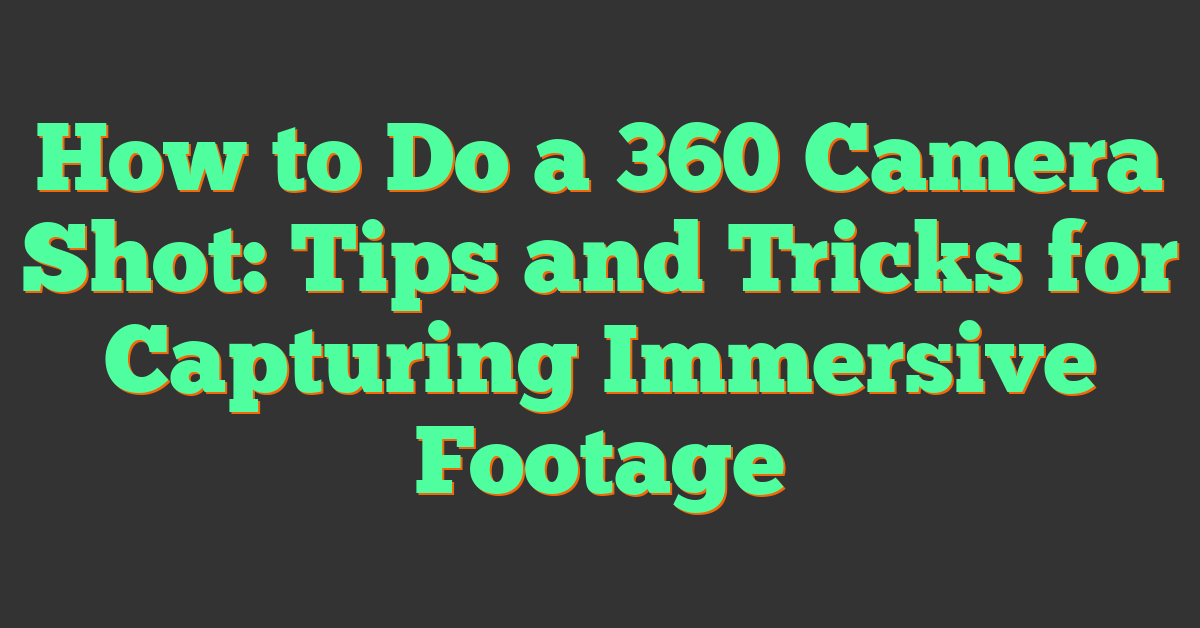Key Takeaways
- 360 cameras are more affordable than ever in 2025, with prices ranging from $150 for entry-level models to over $1,000 for professional-grade equipment.
- Technological advancements like 7K/8K resolution, image stabilization, and AI-driven features have improved performance while reducing costs.
- Market competition from brands like Insta360, GoPro, and new entrants has driven significant price drops, enhancing accessibility for both hobbyists and professionals.
- Streamlined production methods and the use of recycled materials have contributed to affordability without sacrificing quality.
- Diverse pricing options cater to various needs, from budget-friendly models for casual creators to high-end cameras for VR filmmakers and professionals.
- Comparing 2025 to past trends reveals a decade of steady price decreases and improved features, making 360 cameras a cost-effective investment for immersive content creation.
I’ve always been fascinated by how quickly technology evolves, and 360 cameras are no exception. Once considered a luxury for tech enthusiasts, these cameras have become increasingly accessible over the years. But in 2025, just how affordable are they for the average consumer?
With advancements in manufacturing and growing competition, prices have shifted dramatically. Whether you’re a casual creator or a professional, understanding the value and features you’re getting for your money is key. Let’s dive into what’s driving these changes and whether a 360 camera fits your budget this year.
The Evolution Of 360 Cameras And Their Pricing
360 cameras entered the market as niche tools, favored by professionals and hardcore tech consumers. Early models, like the Panono launched in 2014, cost over $1,400 and required extensive post-processing to merge images seamlessly. Limited competition and complex technology kept prices beyond reach for most creators.
With advancements in image stabilization, stitching algorithms, and sensor technology, manufacturers started reducing production costs. By 2016, models like the Samsung Gear 360 and Ricoh Theta S offered consumer-friendly prices under $400. This marked a turning point, making 360 photography accessible to enthusiasts beyond professionals.
As demand grew, competition intensified. Leading brands like Insta360 and GoPro introduced high-quality yet affordable models. For example, the 2019 Insta360 ONE R, priced at approximately $480, offered modular features that appealed to both casual users and professionals. These shifts significantly diversified pricing options by 2020, starting below $300 for entry-level models.
By 2025, the trend expanded further. Compact models offering 5.7K video resolution and real-time stitching became available for under $250. Professional-grade cameras like the Insta360 Titan catered to VR filmmakers, pricing above $15,000 but with features aligning with industry needs. This broad spectrum reflects how innovation and market competition continually influence affordability.
Key Factors Influencing 360 Camera Affordability in 2025
360 cameras continued evolving in 2025, driven by technological advancements, a competitive market, and more efficient production techniques. These factors shaped prices and accessibility for creators of all levels.
Advancements In Technology
Enhancements in sensor quality, image stabilization, and AI processing directly impacted affordability. With 7K and 8K resolution now standard for consumer models, manufacturers integrated powerful processors to handle high-quality stitching and real-time editing. Progress in miniaturization allowed compact designs without compromising performance, a shift from bulky early models. For instance, advanced storage solutions like in-device SSDs reduced reliance on external hardware, lowering long-term usage costs.
Increased Market Competition
The 360 camera market saw fierce competition among established manufacturers and emerging startups in 2025. Companies like Insta360, GoPro, and Kandao consistently launched affordable models with competitive features, forcing mid-tier and professional-grade camera prices to stabilize or drop. Entry of smartphone brands producing modular 360 camera accessories further diversified options. For creators, this meant access to feature-packed devices under $300 and professional equipment at more attainable price points compared to previous years.
Production And Manufacturing Costs
« Action vs. VR 360 Cameras: Which One is Right for Your Adventures?
The Rise of 360 Cameras in the Digital Age: How They’re Revolutionizing Content Creation »
Reduced component costs and streamlined production improved 360 camera affordability. Innovations in automated assembly processes and increased reliance on recycled materials helped lower expenses without sacrificing quality. Widespread adoption of efficient manufacturing practices also allowed brands to focus on scaling without overpricing. High-volume manufacturing in countries like China and South Korea ensured wide availability and consistent price drops across global markets, enabling enthusiasts to upgrade more frequently.
Price Ranges: Entry-Level To Premium Options
360 cameras in 2025 cater to a wide range of budgets, making them accessible to hobbyists and professionals alike. Depending on the features and use cases, prices vary significantly across budget-friendly, mid-range, and high-end categories.
Budget-Friendly 360 Cameras
For those starting with 360 photography, budget cameras offer essential features at a low cost. Entry-level models range from $150 to $300. They capture 4K video, provide decent image quality, and include basic stabilization. Cameras like the Insta360 X3 and Ricoh Theta SC2 are popular in this segment. These options work well for casual users capturing travel videos or social media content but may struggle in low light or complex video editing workflows.
Mid-Range Models
Mid-range options, priced between $300 and $600, balance affordability with functionality. These cameras often include 5.7K video resolution, better stabilization algorithms, and improved durability. Devices like the GoPro MAX and Insta360 ONE RS 1-Inch Edition dominate this category. I’ve seen these cameras perform well in action shots and VR tours, making them ideal for enthusiasts wanting high-quality output without paying premium prices.
High-End Professional 360 Cameras
High-end models exceed $1,000 but offer unparalleled performance for professionals. Cameras like the Insta360 Pro 2 and Kandao Obsidian Pro deliver 8K or higher resolution footage, advanced stabilization, and pro-grade editing compatibility. With features such as multi-lens configurations and AI-based enhancements, they’re a staple for filmmakers and virtual reality content creators. These models are best suited for professionals requiring optimal quality and maximum creative control in their projects.
Comparing 2025 Versus Previous Years
360 cameras have become significantly more affordable and feature-rich over the past decade, making them accessible to more photographers and videographers. I’ve observed remarkable shifts in pricing trends and technological capabilities since my time in the industry.
Price Drops Over The Last Decade
Over the past ten years, 360 camera prices have consistently fallen while quality has improved. In 2015, premium models like the Panono retailed for upwards of $1,400, catering mainly to niche users. By 2018, competition from brands like Samsung and Ricoh introduced models under $400. Then by the early 2020s, companies like Insta360 and GoPro reduced entry-level camera pricing to nearly $250 without compromising essential features.
By 2025, even budget-friendly models offer 7K footage for under $300, closing the pricing gap between low and mid-range options. Professional-grade cameras, once exclusive and priced over $3,000, now start at $1,000 while offering unparalleled VR capabilities. Market expansion and streamlined production, especially with innovations like recycled materials, have made this downward trend possible.
Value For Features In 2025
The value packed into 360 cameras in 2025 is unmatched when considering their affordability. For less than $300, budget models include advanced AI-driven stabilization, waterproof builds, and high-resolution capture that enthusiasts and hobbyists can depend on. For creators like me, working with mid-range cameras priced at $400-$600 means enjoying high frame rates, crisp 8K video, and robust app integrations, ideal for virtual tours and immersive media.
At the professional level, spending $1,000 or more opens access to cameras with industry-leading features like multi-lens systems and RAW VR video capture, which were aspirational just a few years back. Whether you’re an occasional 360 content creator or a VR filmmaker, 2025 models deliver an optimal mix of cost and capability for any budget.
Are 360 Cameras Worth The Price In 2025?
In 2025, 360 cameras offer exceptional value for both hobbyists and professionals. Entry-level models, priced between $150 and $300, make it easy for beginners to create immersive content. Cameras like these now feature 7K resolution, basic image stabilization, and user-friendly mobile apps, allowing casual users to capture stunning panoramas, family events, or virtual tours without overspending.
For enthusiasts and semi-professionals, mid-range 360 cameras priced from $300 to $600 provide a significant step up. These models include 8K video, improved stabilization, higher dynamic range, and faster frame rates. For instance, devices in this segment handle dynamic lighting conditions better, ensuring smoother motion captures and more vivid color rendering. I often recommend mid-range options to creators using 360 footage for social media or AR/VR projects.
High-end models in the $1,000+ category remain the go-to for professional videographers and VR filmmakers. These cameras deliver industry-leading features like cinematic-grade 12K resolution, advanced AI-assisted editing tools, and superior low-light performance. For professionals working on VR documentaries, game design, or interactive tours, these features justify the premium price.
Considering the advancements and wide range of options, 360 cameras in 2025 balance performance, innovation, and cost more effectively than ever.
Conclusion
The landscape of 360 cameras in 2025 reflects a perfect blend of innovation, accessibility, and affordability. Whether you’re a casual creator exploring immersive content or a professional filmmaker seeking high-end tools, there’s a model to match your needs and budget. With advancements in technology and competitive pricing, creating stunning 360-degree content has never been more attainable.















